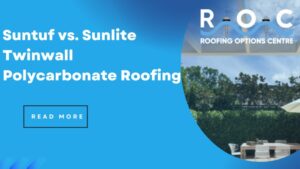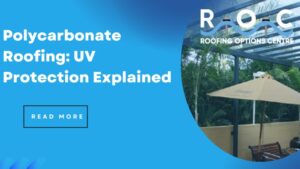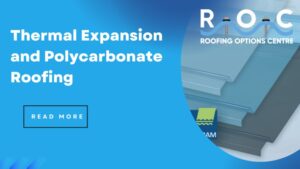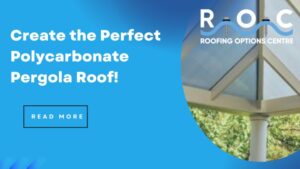Are you changing up your pergola or patio with Polycarbonate roofing? With a variety of colours and styles to choose from in this thermoplastic material, it can be an overwhelming choice to make. Thankfully, there’s something for everyone’s comfort level!
According to the Polycarbonate Roofing website, as a general rule of thumb, the more light that comes through the sheet, the hotter it will feel underneath the sheet. For example, SUNTUF’s SolarSmart range skews the amount of light available without letting much heat in.
This blog will highlight the different colours and their light transmission, heat reduction, and how to know what is right for your upcoming roofing project.
Why is Roofing Important for Energy Efficiency?
The aesthetic appeal of your roof has more of an effect on your outdoor spaces than you might think.
Roofing impacts how much light and heat is absorbed or reflected by the surface, and this actually affects indoor temperatures and how much energy is used for cooling. What affects the energy efficiency of your roof?
Heat retention
Since the air in your roof cavity is warmer than the air in the rest of your home (hot air rises!), roofs are exposed to solar energy from the sun. Your roof affects insulation and whether heat is conducted.
Ventilation
If you control the heat trapped in your roof cavity, heating and cooling costs can be cut back. You can use the vents in the soffits of your eaves to encourage warm air to exit the roof’s apex. This draws cool air into the roof, pushing hot air upwards.
Insulation
During winter, internal heat conducts outward through the roof and walls and impacts thermal insulation. Hot air can escape through gaps around windows, doors, and ceiling, so roofing insulation (such as ceiling batts) can be a good buffer.
That said, houses in water climates such as Queensland as opposed to Melbourne don’t need bulk insulation so it’s a good idea for cladded or painted roofing that releases and reflects solar energy.
Eaves
Providing shade to your home’s exterior, eaves designed correctly can block out heat during warmer months and absorb the sun during winter days.
Many components of your roofing system result in a level of insulation and heat reflectance, and the colour of Polycarbonate roofing (used for your outdoor living spaces) makes a big difference.
Do you want excellent UV protection while hanging out with friends and family in hot weather? Roofing Options can support you with Polycarbonate roofing applications.
How Does Colour Affect Heat Reflection and Light Transmission?
If you’ve ever heard someone say “black clothing absorbs more heat” it’s technically true. Dark-coloured materials both absorb and emit energy more than light-coloured materials, whereas light colours (like yellow, light blue, and pastels) reflect more heat.
White reflects all wavelengths of light, so it is the best at knocking back sunlight! Let’s take a look at how roof colour determines the effects of heating and cooling.
Light-Coloured Roofs
White or translucent polycarbonate options reflect more sunlight and heat, which helps to keep areas cooler! If you have spaces exposed to a lot of afternoon sun,
Arguably, clear polycarbonate is considered the best roofing option for clarity and durability in even the harshest of environments.
Dark-Coloured Roofs
Dark-coloured roofing often absorbs more heating, which increases the temperature of the spaces underneath. Although this is great during winter months, it makes summer uncomfortable and possibly hikes up your cooling expenses.
Tinted Options
If you want a balance between heat reduction and light transmission, even during extreme temperatures, tinted polycarbonate sheets reduce glare while still offering excellent thermal performance.
What will influence your decision-making process?
- SHGC, or Solar Heat Gain Coefficient, describes how much heat is passing through the material. The lower the number (between 0 and 1), the less heat.
- U-value, which measures how well heat is transferred through a material. The lower the U-value, the more insulation the material gives.
- The purpose of the Polycarb! A patio for BBQs will need cooler-coloured sheeting.
- The height of your roof and how much airflow it gets. The lower your roof, the warmer an area will feel.
- The lighting. Do you want more light in a certain part of your home?
- Colour scheme. Do you want a striking colour or an opaque choice?
Polycarbonate Roofing Colour Options: A Quick Guide
Here’s a general overview of the different colours, their light transmission, heat reduction, and comparisons to give you a better idea of what to look for.
Laserlite 2000
A classic, high-performing Laserlite range:
Clear: Light transmission 93%, heat reductions 0%
Opal: Light transmission 49%, heat reduction 52%
Cream: Light transmission 43%, heat reduction 62%
Bronze Tint: Light transmission 38%, heat reduction 33%
Grey Tint: Light transmission 19%, heat reduction 0%
For summer, Cream and Opal are the best options!
Laserlite 3000
A technologically advanced, heat-reflective range:
Platinum: Light transmission 18%, heat reduction 69%
Frost: Light transmission 47%, heat reduction 63%
Gun Metal: Light transmission 16%, heat reduction 66%
With Laserlite 3000, you can experience up to 50% better heat reduction performance than a standard corrugated sheet in the hot afternoon sun.
In summer, Frost, Gun Metal, and Platinum are good choices.
SUNTUF EZ Glaze
Source: EZ Glaze Leaflet AU
Clear: Light transmission 90%, solar heat gain 0.86
Grey: Light transmission 20%, solar heat gain 0.44
Breeze: Light transmission 70%, solar heat gain 0.53
For summer days, Clear is the best choice for your home.
Palram Sunsky
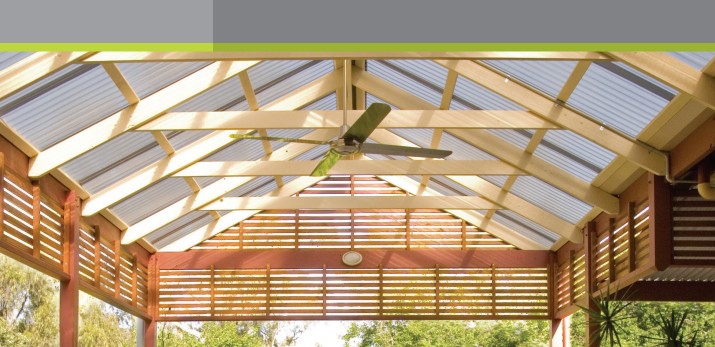
SunSky 2001
Grey: Light transfer 20%, heat transfer 43%
Cream: Light transfer 44%, heat transfer 33%
Bronze: Light transfer 25%, heat transfer 48%
White Opal: Light transfer 45%, heat transfer 40%
Clear: Light transfer 90%, heat transfer 86%
Choose Clear SunSky 2001 for summer days and nights!
SunSky 3001
Solar Ice: Light transfer 25%, heat transfer 35%
Solar Control: Light transfer 25%, heat transfer 34%
Metallic Jasper: Light transfer 15%, heat transfer 16%
Sandune: Light transfer 15%, heat transfer 15%
Smart Grey: Light transfer 20%, heat transfer 35%
When the weather gets warmer, pick Smart Grey or Solar Ice.
Ampelite Polycarbonate
Level 1 SolaSafe range, which is the most widely-used Solasafe polycarbonate roofing material. Six colours with varying light and heat transmission
Clear: Light transmission 91%, heat transmission 85.2%
Opal: Light transmission 55%, heat transmission 40.2%
Lt. Bronze: Light transmission 36%, heat transmission 60.6%
Dark Tint: Light transmission 17%, heat transmission 38.9%
Grey: Light transmission 26%, heat transmission 50%
Smooth Cream: Light transmission 44%, heat transmission 44%
To reflect the sun’s heat during summer, your best bet is Clear, but you can opt for Lt. Bronze if you don’t mind a little warmth coming in.
Level 2 SolaFrost range with low transmitted heat, softer light, and more comfort
Clear: Light transmission 87%, heat transmission 74.3%
Grey: Light transmission 27%, heat transmission 49.87%
Grey is an ideal choice for hot days as it bounces back the hot sun.
Level 3, the HR1 range which reduces sheeting and is especially suitable for hot climates
Pearl Ice: Light transmission 48%, heat transmission 32.5%
Silver Mist: Light transmission 17%, heat transmission 22%
Choose Pearl Ice for warm days, but be aware it doesn’t have as high heat transmission as other Polycarbonate sheeting.
The Level 3 SolarSafe HR1 has a metallic finish that reflects the heat and gives soft, diffused light!
So, what colour is best for light and heat transmission in the summer?
It depends on your performance needs, project specifications, and, ultimately, the level of comfort you’re looking for.
If you don’t mind the patio being a bit warmer in summer, Clear is a popular choice. On the other hand, dark grey or bronze tones don’t allow for much natural lighting, but they’re a better insulator for winter days when you want fresh air. Roofing Options can help you make an informed decision.
Whether you’re keen on Laserlite 2000 and 3000, SUNTUF EZ Glaze, Palram Sunsky, or Ampelite, Roofing Options delivers roofing supplies to Broadmeadows, Lalor, Reservoir, Thornbury, Preston, Coburg, and Endeavour Hills!
Reliable Steel Roofing Supplies in Melbourne: Call Roofing Options
Whether you’ve wanted polycarbonate roofing sheets for more natural light at home, protection from UV radiation and extreme weather conditions, or just want a Polycarbonate colour that plummets energy costs, Roofing Options can help.
Are you a builder, contractor, homeowner, or DIY enthusiast? At Roofing Options, we only source and supply high-quality materials by trusted brands manufactured to the highest Australian standards. If you’re ready to order, looking for specialist advice, or want a roofing quote, call 03 9354 2633 or contact us today at sales@roofingoptions.com.au, and our team of experts will answer all of your questions.
Feel free to visit our Cranbourne, Coburg, and Campbellfield stores!
